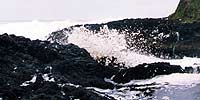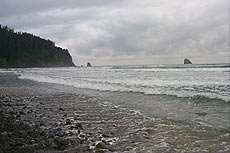 |
Back to Oregon Coast
Contact Advertise on BeachConnection .net
Mother Nature Becomes a Freak on Oregon Coast
Published 12/23/2008
 |
| Sea foam at Gleneden Beach: you'll see some amazing sights with stuff in winter and spring. |
(Oregon Coast) - Oregon's oceanic shoreline is one of the most dramatic and dynamic places on the planet, along with its renown for pristine, unspoiled beauty. The very aspects that keep it so wild and wooly, especially in the weather department, make it an ever-changing place with a unique ruggedness that hides dozens of interesting, even weird possibilities. Big winds knock this part of the Pacific Ocean around with reckless abandon, and in turn, those waves carve out the landscape in surprising ways.
Here, Mother Nature can be a serious freak – but in a delightful way.
Some of the wildest sights happen in spring, others occur year-round but are merely augmented during this particularly wacky time of year. Weird, noisily animated rocks nicknamed “magic rocks. The Pacific “burping.” Foam that looks like snow going the wrong way. And of course, do you know what sea foam is actually made of?
 |
| Crazed foam hits the Devil's Churn near Yachats. Here, it actually floats upwards, looking like snow going the wrong direction. |
Strange Sea Foam Sights
Awe-inspiring oddities can happen a little more often at this time of year as well, thanks to phytoplankton known as diatoms – the little creatures that create sea foam. Bill Hanshumaker, public information officer for the Hatfield Marine Science Center in Newport, said these tend to bloom in greater numbers in the spring, and seasonal storms can result in incredible sights such as foam so frothy it moves like flurries of snow across the beaches and highways.
Big storms are mostly gone on the coast by spring, but smaller yet spectacular ones do hit the coast in April, causing dramatic waves, odd things getting tossed onto beaches, mass strandings of sea creatures as well as the snow-like flurries of sea foam.
 |
| Near Arch Cape, the beach known as "Magic Rocks" beach. |
Magic Rock Beaches
It's called "magic rocks," and it's a puzzling, esoteric noise created by stones moving and crackling in the tide.
One is even nicknamed Magic Rocks Beach because it happens here constantly.
Some beaches – mostly on the north coast - have a proliferation of small to large, rounded stones that have been polished by the tides. These rocks, in turn, will make an odd rattling noise when disturbed by the tides as they wash across them in the sand. In some places, the noise is soft, rare or infrequent, but occurs in places you wouldn’t normally think it would. In others, it is loud, even to the point of almost a roar, and so constant it inspires the term “magic rocks.”
 |
| Bayocean, where the rocks can be extremely loud. |
It’s as if the tides momentarily give these rocks life, and they shimmy, shake and shudder as they make a rattling noise, like giant Mexican jumping beans that have grown to freakish side and now inhabit the tideline.
The name “magic rocks” actually comes from a nickname the locals have given to a beach just south of the Arch Cape Tunnel - one that’s almost completely made up of these polished stones, and where the sound is almost continuous. They call it “Magic Rocks” beach, and it is unusual in other ways.
 |
| Beneath Yaquina Head there are large, black cobblestones that are quite raucous. |
Besides being one of the most completely hidden beaches on the entire coastline, this massive landscape of those polished stones changes shape constantly. And since that’s mostly what the beach is made up of, the beach itself changes its look constantly. There are often tiers carved by the tide, which shift in shape, number, size and direction sometimes several times a day.
Some of the beaches at Oceanside also have a touch of this quality. It’s also quite strong at the black sanded beach at the bottom of Yaquina Head, Rock Creek Campground between Yachats and Florence, in other parts of Arch Cape, and often really loud in the little village of Cape Meares, which is on the Bayocean Spit and next to the cliffs also called Cape Meares.
 |
| This egg casing from a skate yielded several baby creatures still seen at the Seaside Aquarium (photo Seaside Aquarium). |
When the Ocean Burps
“Whale burps” is the nickname for rock-hard bundles of sea grass that have been compressed together.
There are also “ocean burps,” a very loose term for bundles of sundry objects that get stuck together and tossed up by the tide, which often yield still living specimens like live egg casings from various species. The technical term is detritus, and it means the ocean is casting some interesting objects from the depths onto the shores – things you don’t normally find on the beaches.
 |
| Ocean burps sometimes mean live crabs (photo Seaside Aquarium). |
Many living things can be found in the “ocean burps,” which is exactly what Seaside Aquarium staff encounter every year. One episode of this detritus occurred in February of 2006, where manager Keith Chandler found 30 live cockleshells – a form of clam. He also found numerous squid egg casings and some live squid eggs, which eventually did hatch at the aquarium, although they didn’t live long.
Also found in this mass of messy, mesmerizing stuff are moon snail shells. These are rare, Chandler said, and quite attractive, with their intricate, swirling designs. “They can be about the size of a baseball,” he said.
 |
| More live eggs found at an ocean burp. |
Chandler said these ocean burps happen under just the right conditions, when the right mix of storms happen along with the right kind of ocean currents. Spring storms bring them quite often, so expect to see some soon, he said.
“It’s an upwelling of stuff from the ocean floor,” Chandler said. “If you see a patch of dark brown on the beach, go look through it because you’ll find some cool stuff.”
Spring storms bring as many surprises as winter storms, maybe even more, considering that’s when many species reproduce in great numbers, and thus have a better chance of showing up onshore.
Indeed, in 2005, one Newport resident found a glass float after a spring storm. Danielle Emerick, manager of Starfish Point, found the ancient Japanese remnant lying around Agate Beach, on the north end of Newport.
More About Oregon Coast hotels, lodging.....
 |
 |
LATEST OREGON COAST NEWS STORIES
Oregon Coast, Valley and Likely Washington Coast to Get Some Aurora Borealis ... |
Secrets of the Season |
Unusual Travel Articles TravelParanormal.com allows you to submit your own creepy tale or debunk one - or see up-to-the-minute news headlines about travel and the paranormal. News Headlines from All Over Oregon Need to scan Oregon headlines? Constantly updated news from all over Oregon: a comprehensive, up-to-the-minute display of news headlines from a variety of media |






































